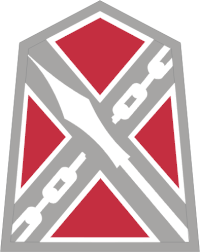Fort Pickett
| Fort Pickett | |
|---|---|
| Blackstone, Virginia | |

Shoulder sleeve insignia of the Virginia Army National Guard
|
|
| Type | National Guard Training Site |
| Site information | |
| Controlled by | Virginia National Guard |
| Site history | |
| Built | 1942 |
| In use | 1941–present |
| Garrison information | |
| Garrison | Army National Guard Maneuver Training Center |
Fort Pickett, is a Virginia Army National Guard installation, located near the town of Blackstone, Virginia. Home of the Army National Guard Maneuver Training Center, Fort Pickett is named for the United States Army officer and Confederate General George Pickett.
Late in 1941, as war drew closer to America’s shores, a team of Army surveyors visited the site of a former Civilian Conservation Corps camp near the small rural town of Blackstone, Virginia. There they found enough land, water and other resources needed to establish a post large enough to simultaneously train more than one infantry division. The site also offered easy railroad access to both mountain and coastal training sites. By December, 1941, 45,867 acres (185.62 km2) of land in Nottoway, Dinwiddie, Lunenburg and Brunswick Counties were acquired and cleared to prepare for construction of the first buildings.
Elements of the Virginia National Guard had their first taste of what is now Fort Pickett on Dec. 6-7 when the 1st Battalion, 116th Infantry, camped here on the way back to its home station at Fort Meade, Maryland, having completed a series of war games in North Carolina.
The rapid development of Fort Pickett became a top priority after U.S. entry in World War II. Two rail spurs were built into the camp in 1942-1943 to increase logistical efficiency and the rapid movement of troops on and off post. Air transportation to and from Pickett became available with the completion of a Blackstone Army Airfield in late 1942. The tower was placed beside the only hangar built on post, and its steel beam frames and cinder block foundation are still visible today. Since each cement runway was 5,269 feet long and 300 feet wide, the four-runway airfield was large enough to allow the safe landing of the Douglas C-47 “Gooney Bird”. Fighter planes could use the runway in an emergency, although none were stationed at the airfield. Aircraft fuel was delivered by rail and contained in fuel trucks, since permanent storage tanks were not constructed until after World War II. The airfield remained virtually unchanged until the 1990s.
...
Wikipedia
